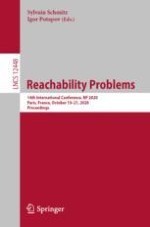This book constitutes the refereed proceedings of the 14th International Conference on Reachability Problems, RP 2020, held in Paris, France in October 2020.
The 8 full papers presented were carefully reviewed and selected from 25 submissions. In addition, 2 invited papers were included in this volume. The papers cover topics such as reachability for infinite state systems; rewriting systems; reachability analysis in counter/timed/cellular/communicating automata; Petri nets; computational aspects of semigroups, groups, and rings; reachability in dynamical and hybrid systems; frontiers between decidable and undecidable reachability problems; complexity and decidability aspects; predictability in iterative maps; and new computational paradigms.
